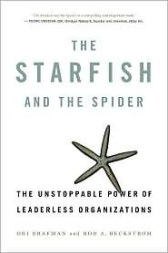Should CISV decentralize and give more power to the chapters?
Sarah/USA referred me to this very interesting book, called "The Starfish and the Spider": The Unstoppable Power of Leaderless Organizations". I haven't read it (yet), but on the cover it says:

The Starfish and Spider concept transfered to CISV initiated a few thoughts:
Sarah/USA referred me to this very interesting book, called "The Starfish and the Spider": The Unstoppable Power of Leaderless Organizations". I haven't read it (yet), but on the cover it says:

"One thing that business, institutions, governments and key individuals will have to realize is spiders and starfish may look alike, but starfish have a miraculous quality to them. Cut off the leg of a spider, and you have a seven-legged creature on your hands; cut off its head and you have a dead spider. But cut off the arm of a starfish and it will grow a new one. Not only that, but the severed arm can grow an entirely new body. Starfish can achieve this feat because, unlike spiders, they are decentralized; every major organ is replicated across each arm."If you look at CISV's structure, we have elements of both: The chapters could be viewed as the legs of starfish, where from each one a new organization could spring off. In many ways we are pretty decentralized. But as a whole, I'm afraid CISV is still a spider with a huge head, read IO/AIM/IEC/Committees.
The Starfish and Spider concept transfered to CISV initiated a few thoughts:
- It takes some courage to reduce the overhead structure. Can anybody imagine CISV without AIM, IEC or IO? I do think it could be possible, and maybe liberate energy in chapters and NAs: Take away the heavy burden of financial and human resources to keep the international structure alive, and many a chapter could use them elsewhere. The chapters could become more creative, invest more time in local activities, and so on.
- The Mosaic programme is an example where a starfish was turned into a spider. I'd have to admit though that the starfish Local Work was barely alive. Maybe Mosaic could be turned back into a starfish some day.
- Somebody submitted a proposal to CISV Devils some time ago, suggesting that there are things we could learn from Al Quaida, a perfect Starfish. Even without the head (=Bin Laden), the idea would live on. Even if not based on religious belief, shouldn't the CISV idea be strong enough to survive without central management?
